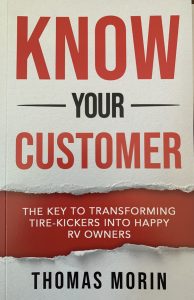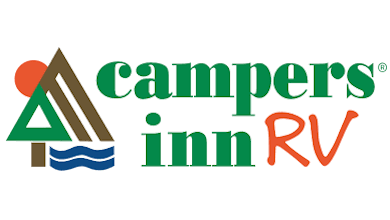Blog: Know Your Customer’s ‘What’
 Morin
MorinEditor’s note: This is the second in a four-part blog series taken from author and career coach Thomas Morin’s book, “Know Your Customer: The Key to Transforming Tire-Kickers into Happy RV Owners.” Part III and Part IV will run the following Mondays.
Let’s face it, customers love walking through all RVs at a dealership and looking at all the cool things inside … more so now than ever before. RVs have so many unique and interesting features today, customers often get the “kid in the candy store” feeling walking through them.
However, it’s easy for customers to lose track of the fact that every time they choose features this way, the price goes up, creating sticker shock. In addition, too often, customers want features they don’t need because they’re caught up in this imaginary competition with the couple down the street or the campsite next to them.
Some salespeople mistakenly try to create this feeling, but when doing so, they run a huge risk of selling the customer what they want rather than what they need. The goal of the salesperson should be to find the perfect RV for the customer standing in front of them. What was perfect for the last customer no longer matters.
To avoid this mistake, there are some practical steps salespeople must take to get the information they need to put customers on the right product.
Think Long-Term Customer Relations
Referrals drive the most profitable RV sale. Selling customers the RV that’s right for them will not only generate repeat sales, but also referral sales.
Don’t forget that customers love to sit around the campfire and talk about their experience with their salesperson. If it went well, they’ll openly advertise for their salesperson. If the salesperson sold them the wrong RV, word travels fast through the campsite.
Realize That Customers Don’t Always Know What’s Best for Them
Customers are doing more internet research prior to coming to the dealership than ever before. As a result, doing so can get them too enamored with features that might give them bragging rights at the campsite, but doesn’t fit how they plan to use their camper or their budget. Even if customers tell you what features they really want, it’s typical that those might not fit how they actually plan to go camping.
Be A Question Box
Identifying the perfect RV for each customer is a building process that starts with progressive questioning that helps the customer paint the picture of the perfect camping trip.
Asking basic questions about where they like to go, how long they like to stay are important, but you need more information. Each answer a customer gives you must lead you to the next question that helps the customer build a vision in their mind.
It’s not just about where the customer likes to camp, but also details of what their life looks like while they are there. Activities, events (even the simple ones like sitting around the fire) and how they transfer their life from home to the campsite helps to build their vision.
Be an ‘Active Listener’
The way we typically listen every day won’t quite cut it. There must be a strong focus on listening – rather than on what you might say next. Without it, you will not only miss what is being said, but most importantly, what a customer means. Some customers are reluctant to tell you straight out what you need to hear and will just give cues that you must pay attention to.
Getting a Customer Budget
You must have some basic budget parameters before walking out in the lot to look at RVs. I promise that they can’t afford everything in the lot.
Some customers like to walk in every RV just to get ideas about how to decorate their camper, almost like people who go to home sale open houses on Sundays to find decorating ideas from people trying to sell their home. This cannot be allowed.
Asking for and getting an honest spending range will eliminate 75 to 80 percent of the product in the lot, so you can spend time efficiently looking at product that does fit their budget.
Note Taking
You might think you can remember everything a customer tells you, but you cannot. Taking brief notes will help you piece together the information you need to not just lead them to the RV that is perfect for them, but why it is perfect for them.
Uncooperative Customers
Dealing with the customer who is belligerent or unwilling to give you the information you need to best serve them can be uncomfortable. Although it’s best not to get in a fight at this point, you have a decision to make. If you let them go out in the lot and wander around, most will get frustrated and leave, believing you gave them poor service.
Salespeople need to make the decision to be comfortable being uncomfortable during the sensitive 2 minutes it takes to help customers understand that it’s in their best interests to give you the information you to truly help them.
Even if they don’t want to work with you, the reason most customers walked through your door is because they either love camping or love the thought of trying it. Helping them to paint the picture they envisioned when they decided to come to your dealership in a non-threatening, friendly way to get them talking about this vision should open the door for open communications.
Following these simple steps will up your odds of finding the RV that is perfect for your customers every time.
Access Part 1 of this blog series by clicking here.
 Thomas Morin is a veteran corporate executive, business owner and career coach. After joining Alpin Haus in Amsterdam, N.Y., Morin quickly became a top RV salesperson and was named trainer for all new salespeople in the dealership. He was subsequently promoted to sales manager, followed by director of employee development, training/coaching for all RV salespeople in the company. Morin is a certified life and career coach. For more information on Morin and his coaching business, visit his website at: www.unlockyourcareercoaching.com
Thomas Morin is a veteran corporate executive, business owner and career coach. After joining Alpin Haus in Amsterdam, N.Y., Morin quickly became a top RV salesperson and was named trainer for all new salespeople in the dealership. He was subsequently promoted to sales manager, followed by director of employee development, training/coaching for all RV salespeople in the company. Morin is a certified life and career coach. For more information on Morin and his coaching business, visit his website at: www.unlockyourcareercoaching.com



